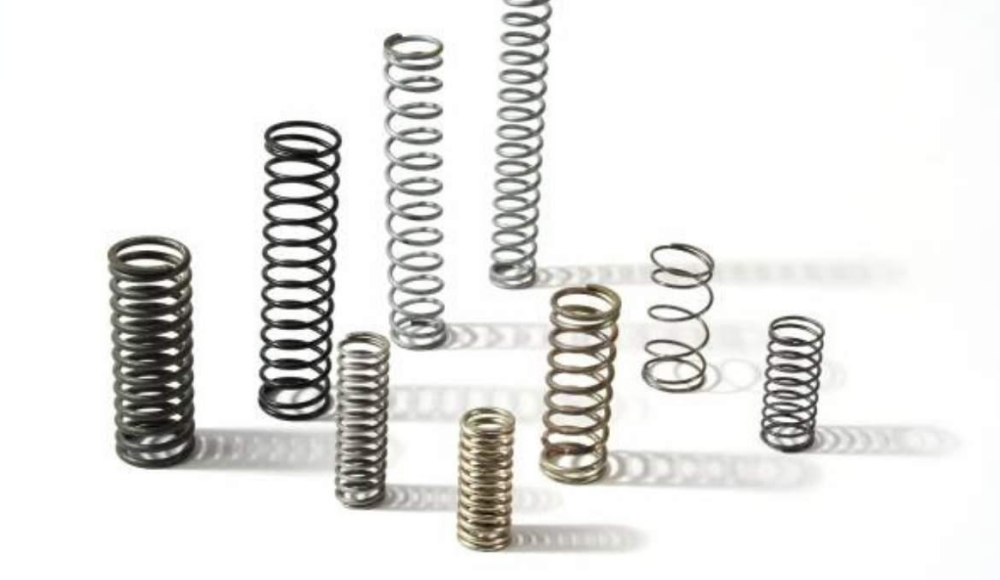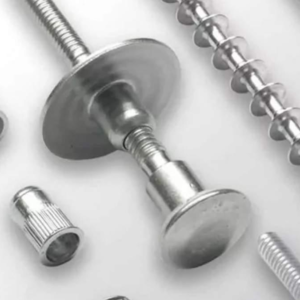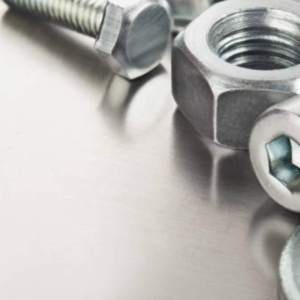Los resortes son piezas mecánicas idénticas para varios componentes.. Están muy empleados en relojes., automóviles, y teléfonos inteligentes. Hay muchos tipos de resortes, y todos varían en sus propiedades, lo que hace que sea difícil elegir el correcto. En este articulo, Discutiremos los tipos de primavera comunes, sus usos, el material que hicieron, e falla mecánica de resorte.
Principio de primavera explicado por la ley de Hook
Los resortes son partes mecánicas, bien capaz de almacenar energía. Almacenan energía al cargarla y liberarla cuando se retira la carga. Este es un acto básico de todas las variedades de primavera y se caracteriza por la ley de Hooke.
De acuerdo con la ley de Hooke.
La fuerza necesaria para comprimir o extender el resorte varía en relación directa con el desplazamiento. Matemáticamente, se representa como:
F = -KX
En esta ecuación:
- F = Fuerza aplicada
- X = fuerza de desplazamiento de primavera/restauración, negativo al desplazamiento.
- K = constante de primavera; Depende de la naturaleza de primavera, e informa sobre una variable que mide la elesos de la primavera.
Tipos de resortes mecánicos
Los resortes se aplican en muchas industrias y campos. Están hechos de muchos materiales y muchas tienen formas, Diferente de los objetos creados normalmente. Los resortes se caracterizan principalmente en tres tipos principales;
Categoría 01: Resortes helicoidales
Los resortes helicoidales se realizan enrollando el cable de manera helicoidal para que las secciones transversales puedan ser variadas. Los principales tipos de resortes helicoidales incluyen:
- Resortes de compresión: Los resortes de bobina abierta se utilizan en compresión sin cargas axiales. Significa que el diámetro del diseño de la bobina no cambia con la carga. Estos resortes se usan en bolígrafos de bolígrafo donde se aloja la acción de "clic" y en la configuración del automóvil donde se están absorbiendo los amortiguación.
- Resortes de extensión: Los resortes de extensión son bobinas cerradas que almacenan la tensión cuando se extienden y regresan a su forma original cuando se libera. Se usan comúnmente en arreglos de tipo extracción, incluidas puertas de garaje y barcazas de peso donde trabajan estirando para medir el peso..
- Resortes de torsión: Los resortes de torsión conectan dos componentes en ángulos específicos. Normalmente funcionan torciendo. Se usan cuando se retuercen y cuando se liberan recuperan su estado natural por el cual liberan energía. El mecanizado CNC es un enfoque ideal para dar forma a resortes de torsión personalizados para uso en volumen a granel.
- Resortes espirales: Los resortes espirales están construidos a partir de tiras de metal rectangular. Son capaces de almacenar energía y luego liberarla de manera uniforme. Estos resortes se emplean de vitalización en relojes mecánicos., juguetes, y movimientos como reclinadores de asientos que ofrecen un tipo específico de movimiento.
Categoría 02: Resortes de hoja
Un resorte de hoja presenta una sección transversal rectangular. Estos resortes están compuestos de placas de metal conocidas como hojas, superpuesto el uno al otro. Estos resortes se usan normalmente en automóviles grandes.. Algunos tipos comunes se mencionan a continuación:
- Primavera de hoja elíptica: Consisten en dos resortes semielípticos en oposición en fases unos a otros para formar una forma elíptica. Originalmente, Se usaron en autos para reemplazar los grilletes, pero han sido reemplazados en la mayoría de los autos modernos..
- Primavera de hoja semielíptica: Estos se usan típicamente en automóviles. Las hojas de acero de diferentes tamaños están unidas a un extremo del marco del vehículo, con el más grande llamado Master Leaf. Estos resortes son muy eficientes para proporcionar un aterrizaje suave durante las operaciones todoterreno.. Además, Son reconocidos por su simplicidad en mantenimiento y durabilidad de alta gama.
- Quarter Ellipse Spring elíptico de hoja: Los tipos elípticos del cuarto o los resortes de tipo voladizo tienen un extremo anclado al marco del vehículo y el otro extremo al eje delantero. Este diseño hace que las hojas se aborre las cargas de choque y los folletos actúen como palancas para disipar el choque.
- Spring de hoja elíptica de tres cuartos: Este tipo de primavera combina características elípticas y semielípticas. La parte semielíptica se fija a la estructura del vehículo y el cuarto de la sección elíptica se fija al eje delantero para una mejor estabilidad.
- Spring de hoja transversal: Los resortes laterales se colocan en los lados. Mientras que los resortes longitudinales corren a lo largo del vehículo. La hoja más larga se encuentra en el fondo, y se agregan dos grilletes al diseño. Tan efectiva como puede ser esta configuración, da como resultado un rodamiento indeseable en algunas aplicaciones automotrices.
Categoría 03: Resortes de disco
Los resortes de disco también se conocen como Washer Springs. Se pueden usar individualmente o en configuraciones en serie o paralelas. Es posible levantar pesas grandes con estos sistemas en áreas limitadas.. A continuación se presentan los tipos principales de resortes de disco:
- Spring de disco de Belleville: Resortes de disco cónico, También conocido como Belleville Springs, Ofrezca acción de resorte cuando se aplica una carga. Su diseño los hace óptimos para soportar cargas sustanciales.. Son relativamente pequeños de tamaño.
- Spring de disco curvo: A veces llamado lavadoras crecientes. Los resortes de disco curvo tienen baja presión que no hará que el sujetador se afloje debido a las vibraciones. Dispersan efectivamente las cargas en pernos, tornillos, y nueces, particularmente en equipos vibrantes.
- Spring de disco ranurado: Implica ranuras alrededor del interior, y bordes exteriores. Es posible lograr una baja capacidad de carga con alta desviación en los engranajes, transmisión automática, y embragues explotando estos resortes.
Funciones de Springs
Los resortes tienen una aplicación significativa en diferentes productos industriales. Aquí están las siguientes funciones de Springs, así como usos.:
Propiedades de absorción de choque
Los resortes son capaces de recibir y expandir o contratarse mediante la aplicación de la fuerza. Esta capacidad les permite administrar bien los riesgos. Por ejemplo, en automóviles, Los resortes reducen la fuerza de impacto cada vez que un automóvil golpea una protuberancia y luego libera energía almacenada lentamente.
Almacenamiento y salida de energía
Los resortes también desempeñan un papel fundamental en el almacenamiento de energía mecánica. Pueden almacenar y descargar energía constantemente y, como tales, son valiosos para reemplazar las baterías en algunos electrodomésticos.. La aplicación prevista está bien ilustrada por relojes mecánicos y pernos de armas.
Control de movimiento
Los resortes pueden controlar el transporte de piezas distintas. Estas aplicaciones se encuentran en muchas industrias, como los garajes., puertas, máquinas de pesaje, Válvulas de motor de combustión internas, y sistemas de control de embrague.
Amortiguación de vibración
Los resortes son herramientas invaluables para reducir las vibraciones. Por lo tanto, ayudan a mejorar la estabilidad de los productos en las áreas de resonancia.. Son funcionales en uso, como en suspensiones automáticas y vagones de tren donde las ondas deben abordarse bien.
Tipos de materiales empleados en la fabricación de primavera
| Material | Características únicas |
| Acero de baja aleación | Resistencia a altas temperaturas; fuerte y duradero. |
| Alambre fría | Aumento de la resistencia a la tracción; mejor tolerancia al calor. |
| Alambre templado de aceite | Resistente a la fatiga; resistir el calor y la deformación. |
| Tira endurecida bainita | Acérrimo; Excelente resistencia a la fatiga. |
| Acero inoxidable | Resistente a la corrosión; Alto rendimiento. |
| Aleaciones de cobre y titanio | Durable; buena resistencia a la corrosión. |
Técnicas de producción general de Springs
Los resortes se pueden producir utilizando varios métodos, incluyendo bobinado, tratamiento térmico, molienda, revestimiento, y acabado. Además, pueden variar según los tipos de resortes, Pero el concepto general sigue claro.
1. Devanado
En este paso inicial, Los operadores alimentan el cable de resorte en una máquina CNC. Próximo, El cable se tuerza en la formación deseada, dependiendo de la especificación requerida del cable. Se utilizan varios métodos durante esta etapa:
- Enrollado: Enrollador utiliza bobinas de resorte o máquinas controladas numéricas de computadora para obtener bobinas establecidas. El proceso se usa comúnmente en compresión, extensión, y resortes de torsión.
- formando: Durante el proceso de formación, Los formadores de resorte CNC se utilizan para crear varios diseños con múltiples curvas y radios. Generalmente, Se aplica a los diseños de resorte de extensión y torsión.
- Doblar: La flexión emplea a los doblares de alambre controlados por computadora para poner el cable en diferentes formas. Este proceso a menudo se aplica en la fabricación de formas de alambre..
2. Trato térmico
El trato térmico permite que los resortes asuman una forma diferente bajo estrés de lo que está destinado a ser. Cada uno de ellos se basa en la cantidad de material, tipo para ser esterilizado, temperatura, y duración requerida para ese material.
3. Molienda
Mollar los extremos de Springs Flat es esencial. Esto permite que el resorte se pare en posición vertical cuando se coloca verticalmente o en otras posiciones. También ayuda a facilitar su función.
4. Recubrimiento y acabado
El recubrimiento y el acabado son fundamentales para mejorar el valor estético de Springs. Por ejemplo, La electroplatación con cobre proporciona una excelente conductividad. Mientras tanto, El recubrimiento en polvo mejora el atractivo visual del artículo. Otros tratamientos de superficie pueden incluir el peening de disparos que se aplica a la primavera trabajada en frío, enchapado, recubrimiento en polvo, y anodizante.
Razones para las fallas de primavera y sus medidas correctivas
Estas fallas pueden ocurrir en la primavera y provocar daños al equipo., Altos costos de mantenimiento, y reducción de la fiabilidad del producto. Es importante tener una revisión de estas fallas para tener en cuenta para fines de prevención: A continuación se presentan causas comunes y sus soluciones correspondientes:
1. Selección de material incorrecto
La elección de los materiales influye fuertemente en las propiedades de los resortes. Al seleccionar los materiales, es posible comprometer las características de los beneficios considerados.. No hacerlo puede conducir a problemas. Por lo tanto, Es aconsejable investigar diferentes materiales antes de elegir.
2. Mala calidad de acabado
Los procesos de recubrimiento y anodización, como el recubrimiento en polvo, aumentan el rendimiento de los resortes. La falta de aplicación adecuada y la exclusión completa de estos procesos expone resortes a la corrosión en entornos hostiles. Por lo tanto, El acabado adecuado es esencial para mantener la integridad de los resortes.
3. Temperatura de funcionamiento indefinida
Los resortes deben ser adecuados para las temperaturas a las que se utilizarán. Es importante elegir materiales que no se deforman a altas temperaturas. El uso de un tratamiento térmico adecuado es otro método de mejora. Además, La aplicación de acabados con alta estabilidad térmica puede mejorar el rendimiento.
4. Palos procesos de fabricación
Los controles de calidad durante la producción son cruciales. Se aseguran de que los resortes funcionen y aparezcan como se esperaba.
Conclusión
Los resortes son indispensables en productos que contienen movimiento. Los resortes se comprimen para almacenar energía y luego se liberan durante la expansión. Para elegir el tipo de primavera correcto, El conocimiento de varios tipos y sus características es obligatorio. La funcionalidad de cada resorte depende del tipo de material que se utiliza, la construcción de primavera, y el mecanismo de ensamblaje. Expertos de consultoría En Spring Design lo ayudará a tomar las decisiones correctas para su proyecto.!



